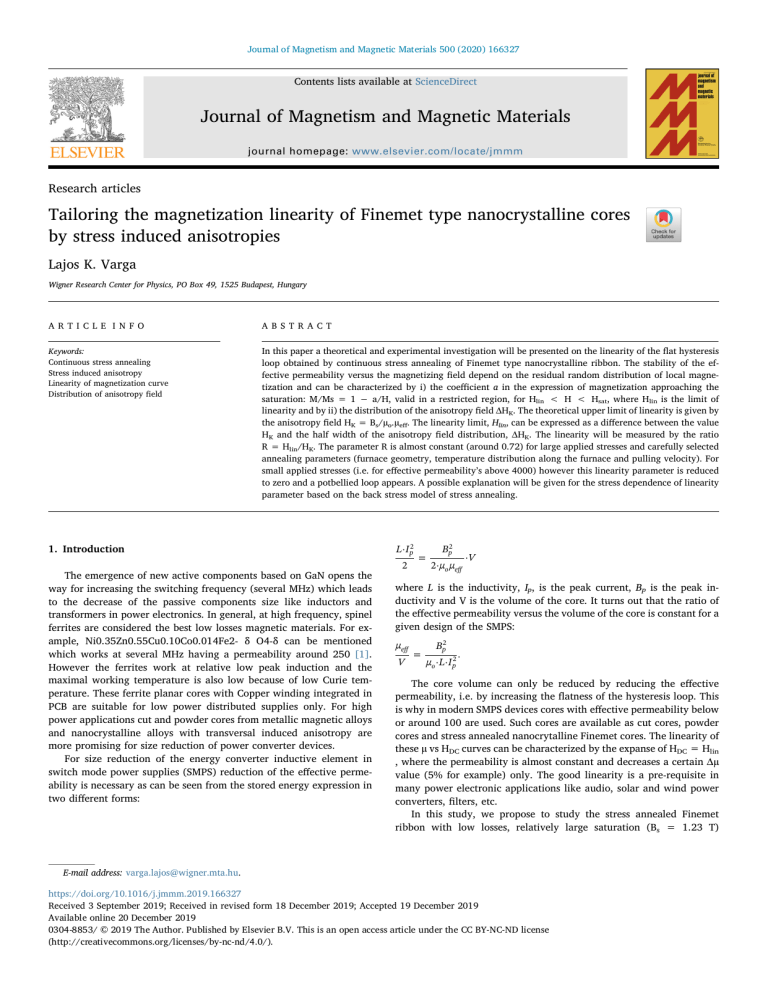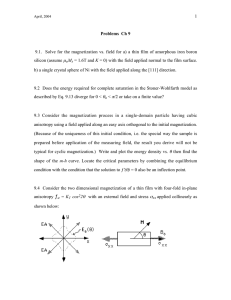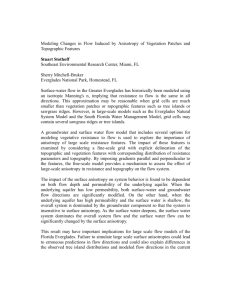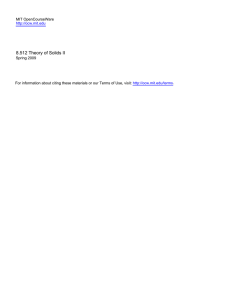
Journal of Magnetism and Magnetic Materials 500 (2020) 166327 Contents lists available at ScienceDirect Journal of Magnetism and Magnetic Materials journal homepage: www.elsevier.com/locate/jmmm Research articles Tailoring the magnetization linearity of Finemet type nanocrystalline cores by stress induced anisotropies T Lajos K. Varga Wigner Research Center for Physics, PO Box 49, 1525 Budapest, Hungary A R T I C LE I N FO A B S T R A C T Keywords: Continuous stress annealing Stress induced anisotropy Linearity of magnetization curve Distribution of anisotropy field In this paper a theoretical and experimental investigation will be presented on the linearity of the flat hysteresis loop obtained by continuous stress annealing of Finemet type nanocrystalline ribbon. The stability of the effective permeability versus the magnetizing field depend on the residual random distribution of local magnetization and can be characterized by i) the coefficient a in the expression of magnetization approaching the saturation: M/Ms = 1 − a/H, valid in a restricted region, for Hlin < H < Hsat, where Hlin is the limit of linearity and by ii) the distribution of the anisotropy field ΔHK. The theoretical upper limit of linearity is given by the anisotropy field HK = Bs/µo.µeff. The linearity limit, Hlin, can be expressed as a difference between the value HK and the half width of the anisotropy field distribution, ΔHK. The linearity will be measured by the ratio R = Hlin/HK. The parameter R is almost constant (around 0.72) for large applied stresses and carefully selected annealing parameters (furnace geometry, temperature distribution along the furnace and pulling velocity). For small applied stresses (i.e. for effective permeability’s above 4000) however this linearity parameter is reduced to zero and a potbellied loop appears. A possible explanation will be given for the stress dependence of linearity parameter based on the back stress model of stress annealing. 1. Introduction L·I p2 2 The emergence of new active components based on GaN opens the way for increasing the switching frequency (several MHz) which leads to the decrease of the passive components size like inductors and transformers in power electronics. In general, at high frequency, spinel ferrites are considered the best low losses magnetic materials. For example, Ni0.35Zn0.55Cu0.10Co0.014Fe2- δ O4-δ can be mentioned which works at several MHz having a permeability around 250 [1]. However the ferrites work at relative low peak induction and the maximal working temperature is also low because of low Curie temperature. These ferrite planar cores with Copper winding integrated in PCB are suitable for low power distributed supplies only. For high power applications cut and powder cores from metallic magnetic alloys and nanocrystalline alloys with transversal induced anisotropy are more promising for size reduction of power converter devices. For size reduction of the energy converter inductive element in switch mode power supplies (SMPS) reduction of the effective permeability is necessary as can be seen from the stored energy expression in two different forms: = Bp2 2·μo μeff ·V where L is the inductivity, Ip, is the peak current, Bp is the peak inductivity and V is the volume of the core. It turns out that the ratio of the effective permeability versus the volume of the core is constant for a given design of the SMPS: μeff V = Bp2 μo ·L·I p2 . The core volume can only be reduced by reducing the effective permeability, i.e. by increasing the flatness of the hysteresis loop. This is why in modern SMPS devices cores with effective permeability below or around 100 are used. Such cores are available as cut cores, powder cores and stress annealed nanocrytalline Finemet cores. The linearity of these µ vs HDC curves can be characterized by the expanse of HDC = Hlin , where the permeability is almost constant and decreases a certain Δµ value (5% for example) only. The good linearity is a pre-requisite in many power electronic applications like audio, solar and wind power converters, filters, etc. In this study, we propose to study the stress annealed Finemet ribbon with low losses, relatively large saturation (Bs = 1.23 T) E-mail address: varga.lajos@wigner.mta.hu. https://doi.org/10.1016/j.jmmm.2019.166327 Received 3 September 2019; Received in revised form 18 December 2019; Accepted 19 December 2019 Available online 20 December 2019 0304-8853/ © 2019 The Author. Published by Elsevier B.V. This is an open access article under the CC BY-NC-ND license (http://creativecommons.org/licenses/by-nc-nd/4.0/). Journal of Magnetism and Magnetic Materials 500 (2020) 166327 L.K. Varga compared to ferrite materials and with variable permeability as a function of applied stress maintaining the low coercive field (below 10 A/m). Applying an optimal nanocrystallization heat treatment, the starting amorphous ribbon becomes a two - phase structure with about 70 vol% Fe-Si nano-sized crystallites embedded in a residual amorphous matrix. The stress annealed ribbon is brittle but still manageable to wound up in toroidal core. The influence of processing parameters on the magnetic properties of continuously stress annealed (CSA) nanocrystalline Finemet type alloy has been the subject of detailed study since the first paper appeared in this topic [2]. Continuous or flash annealing is an industrial applicable process where the ribbon passes between two reels through an open tubular furnace. It was established that the induced anisotropy, K, and the resulting effective permeability (µeff·µo = Js2/2K) depend on the applied tensile stress only and does not depend on the pulling velocity, whereas the elongation of the ribbon during the tensile stress annealing does depend on the pulling velocity. It should be mentioned that in the literature a general view is that the stress induced anisotropy is due to the creep [3]. This is contradicted by the fact that the induced anisotropy does not depend on the stress induced elongation, it depends on the magnitude of the applied stress only [4]. Fig. 1. Schematic diagram of continuous stress annealing equipment. 2. Theoretical part The magnetization curve for stress annealed samples is composed from two regions only: the linear part J= μeff ·μo ·H if H< Hlim (1) and the approach to saturation part J/Js = 1 − a/H if Hlim < H< Hsat , (2) where “a” is the Neel constant and represent the heterogeneities of free volume distributions whose internal stress fields produces a distribution of magnetostrictive anisotropies preventing alignment to saturation. The larger the parameter “a” the more difficult obtaining the saturation and more restricted is the linear part of magnetization. It is worth mentioning that equation (2) can be taken as the first term of the expansion of the exponential: J= Js ∗ exp( −a/H), Fig. 2. Invers permeability as a function of applied stress. R= (3) d 2J . dH 2 Js , μo ·μ (4) (5) 1 ΔHK . 2 (7) Our home built continuous (or flash) annealing equipment [7] is similar to that applied by others [6] with some practical modifications. The equipment presented schematically in Fig. 1 includes an open tubular furnace cut along the length of the cylinder in order to place the running amorphous precursor ribbon into the middle of the furnace. No protective gas is applied during annealing. The ribbon is pulled reel-to reel at constant velocities under a constant tensile stress. The sample coils are rolled up subsequently from the bobbin containing the nanocrystalline ribbon. The pulling force between 1 and 40 N is measured with a dynamometer F and is kept constant through a feed-back to the motor with controlled torque. Both servo-motors have incremental encoder which make possible to read the position values of the motors. From these positions the positive or negative strain of the ribbon can be determined. The negative strain appears at small stresses where the contraction due to the amorphous –crystalline transformation is larger than the elongation due to the creep. The most promising Finemet type composition (Fe73.5Si15.5B7Nb3Cu1) have been used for stress annealing experiments. The ribbon width was 20 mm and the thickness of the ribbon was constant 20 µm. The pulling velocity depends on the length of the which is inversely proportional to the steepness of the magnetization curve, µ. The experimental determined linearity, Hli n = HKexp , however extend up to a smaller value determined by the width of the p(HK) distribution, ΔHK, where: HKexp = HKtheo − . 3. Experimental Its width at half amplitude will be ΔHK. The upper limit for the linearity is given by the anisotropy field HK: HKtheo = HKtheo In the following we will study experimental these parameters of the linearity as a function of induced anisotropy, i.e. as a function of stress applied during annealing. A single or two exponentials (corresponding to domain rotation, DR, and domain wall movement, DWR) can be used to simulate the magnetization region between Hlin and Hsat. The approach to saturation can also be characterized by the width of the distribution of anisotropy field, ΔHK. The distribution of HK will be determined by the Barandiaran method [5] as p (HK ) = −H HKexp (6) For the characterization of the linearity we have adopted the ratio of the experimental and theoretical determined anisotropy fields: 2 Journal of Magnetism and Magnetic Materials 500 (2020) 166327 L.K. Varga Fig. 3. Quasi-DC hysteresis loop (a) and the differential permeability (b) at small pulling stress of 2.5 MPa (F = 1 N). Fig. 4. Quasi-DC hysteresis loop (a) and the differential permeability (b) at medium tensile stress of 100 MPa (F = 40 N). 2400 F = 40 N 2200 2000 1800 B*H 1600 B*H = 1.57*H - 926 1400 a = 590 1200 1000 800 600 1000 1200 Fig. 5. The distributions of the anisotropy fields as a function of the applied pulling forces. 1400 1600 1800 2000 2200 H(A/m) Fig. 6. Determination of the curvature parameter, a, for the sample annealed under stress σ = 100 MPa (F = 40 N). tubular furnace and is set in order to obtain 4–6 s for the running time through the furnace. The annealing is in air and the temperature is set between 873 and 973 K. The pulling velocity of ribbon under tensile stress annealing can be increased up to 1 m/s which makes the productivity of this method competitive with the magnetic field annealing. Js2 3 Ku = − λsFeSi ·σi·νcr = , 2 2μo ·μ (8) where λsFeSi is the saturation magnetostriction of the FeSi phase, σi is the internal residual stress and νcr, is the crystalline fraction, Js is the saturation polarization. The theoretical value for the product (µ·σ) can be calculated from equation (8) as: 4. Results and discussion First we have checked the back stress theory constant (µ·σ) for our sample. The stress induced anisotropy, Ku, is of magnetoelastic origin [3]: μ·σ = 3 Js2 . 3μo ·|λs|·υcr (9) Journal of Magnetism and Magnetic Materials 500 (2020) 166327 L.K. Varga Fig. 7. a) Representation of curvature parameters ΔHK and “a” as a function of applied stress and b) relationship between these two parameters. 1,0 µ·σ has been experimentally determined to be 53850, as it can be obtained from the steepness of the linear dependence of the invers permeability versus applied stress presented in Fig. 2. Theoretically, a similar value, µ·σ = 53535, can be obtained considering: Bs = 1,23 T, λs = −10 ppm and νcr = 0,7. These values of the saturation magnetostriction and crystallized fraction are in accordance with the literature values [3]. In the following we will present some characteristic quasi – DC magnetization curves using a sinusoidal excitation at f = 0,01 Hz frequency on a toroidal sample with 30 mm outer and 20 mm inner diameters. For small applied pulling stress (2.5 MPa) see Fig. 3 the induced anisotropy was not developing in the whole section of the sample, therefore a potbelly hysteresis curve is obtained without a linear initial part. The differential permeability shows no plateau as a function of DC field, its value for small exciting field reaches a high value around 10 000. For intermediate and large applied stresses the hysteresis loop shows a beautiful linearity. The extent of linearity increases with the applied stress, but interestingly the linearity ratio, R, remains almost constant, for properly prepared samples, around 0,70–0,75. Applying the Barandiaran method (Eq. (4)) the distributions of B/Bs B/Bs 1,0 F(N) 0,5 0,5 0,0 1 8 10 16 20 24 32 40 2 H/Hk -0,5 -1,0 -4 -3 -2 -1 0 1 2 3 4 H/Hk Fig. 8. Stress annealed magnetization curves in normalized representation: relative induction versus relative field. HK is the theoretical anisotropy field given by Eq. (5). Fig. 9. Comparison of the normalized magnetization curve a), and of normalized anisotropy field distribution b), for three commercially available cores with flat loops: Cobalt – based zero lambda amorphous, stress annealed nanocrystalline Finemet samples from Magnetec and Imphy companies. 4 Journal of Magnetism and Magnetic Materials 500 (2020) 166327 L.K. Varga anisotropy field, p(Hk), was obtained as a function of applied pulling force. The results are presented in Fig. 5 showing that the higher is the applied force the larger is the width of the p(HK) distribution. Unfortunately, the second description of the approach to saturation using equation (2) is not unequivocal. The parameter a, characterizing the extent of the curvature between the linear and saturated parts of the magnetizing curve can be determined by linearizing the B-H curve, within a range of fields, Hlin < H < Hsat, taken rather arbitrarily, and in addition the parameter Js resulting from the linear fit is higher than the experimental determined Js = 1.23 T. Eq. (2) can be written after linearization as: cores with similar linearity to the Imphy’s cores. 5. Conclusions - The minimal stress region should be further studied to understand the pot belly loop and the lack of plateau in the field dependence of differential permeability. - The linearity ratio, R, for the stress annealed nanocrystalline cores is almost the same for medium and high applied stresses. For our stress annealing technology R is around 0.72–0.74. - On this base, it is possible to represent the DC hysteresis loops in normalized form J/Js versus H/HK, where the loops are almost coincident for a given stress annealing technology. (10) J ·H = Js ·H − Js ·a Taking the data of the magnetization curve from the Fig. 4, the value for the parameter “a” can be obtained from the intercept of the fit and the apparent saturation from the steepness of the line (see Fig. 6.). The curvature parameters determined as a function of the applied stress are presented in Fig. 7a, together with the width, ΔHK, of the anisotropy field distribution. Within the error of determinations both parameter increases linearly as a function of the applied stress indicating a close relationship between these parameters (see Fig. 7b): ΔHK ~ 1.6*a. The linearity ratio can be calculated as: R= HK − 1 ΔHK 2 HK =1− 1 ΔHK 2 HK Declaration of Competing Interest The authors declare that they have no known competing financial interests or personal relationships that could have appeared to influence the work reported in this paper. Acknowledgement This study was partially supported by the Hungarian National Research, Development and Innovation Office, Grant Nr. KFI_16-12016-0079 and by the mobility grant of Hung. Acad. Sciences Nr. NKM91/2019 and by Hungarian OTKA grant No. K 128229. (11) Inserting the stress dependence of ΔHK from Fig. 7a: ΔHK = 53+ 8.71*σ and HK from equation (9): HK = (3λsνcr /Js)* σ = 17* σ in equation (11) we get 1.58 R = 0.74 − σ , which is almost independent from the applied stress for σ > 10 MPa. This allows us to present all the magnetization curves in normalized form as B/Bs versus H/HK (see Fig. 8). In this depiction the magnetization curves almost coincide, having an effective permeability, µeff = 1. For comparison 3 other commercially available cores with transversal induces anisotropies have been measured also with similar effective permeability’s: magnetic field annealed Co-based (zero lambda) amorphous (µ = 1500) core and two stress annealed Finemet samples from Magnetec Hungary (µ = 1600) and from Aperam Alloys Imphy (France) (µ = 1400). In Fig. 9a the normalized magnetization curves are presented and in the Fig. 9b the normalized anisotropy field distributions are shown determined from the double derivative of Fig. 9a using equation (4). The linearity parameter R can be obtained in a straightforward way as the place of the half width at half amplitude of the normalized p(HK) distribution. The linearity is the best for the amorphous Co based core (R = 0.90). Comparing the two stress annealed sample, the linearity of the Magnetec core (R = 0.80) is far better than that of Imphy’s core (R = 0.72). Our technology provides Appendix A. Supplementary data Supplementary data to this article can be found online at https:// doi.org/10.1016/j.jmmm.2019.166327. References [1] Richard Lebourgeois, Eric Labouré, Yves Lembeye and Jean-Paul Ferrieux, LTCC magnetic components for high density power converter, AIP Adv., (2018), 8, 047901, View online: https://doi.org/10.1063/1.4994252. [2] F. Alves, J.B. Desmoulins, D. Hérisson, J.F. Rialland, F. Costa, Stress-induced anisotropy in Finemet- and Nanoperm-typenanocrystalline alloys using flash annealing, J. Magn. Magn. Mater. 215–216 (2000) 387–390. [3] G. Herzer, Creep induced magnetic anisotropy in nanocrystalline Fe-Cu-Nb-Si-B alloys, IEEE Trans. Magn. 30 (1994) 4800–4802. [4] E. Csizmadia, L. Varga, Z. Palánki, F. Zámborszky, Creep or tensile stress induced anisotropy in FINEMET-type ribbons? J. Magn. Magn. Mater. 374 (2015) 587–590. [5] J.M. Barandiaran, M. Vazquez, A. Hernando, J. Gonzalez, G. Rivero, Distribution of the magnetic anisotropy in amorphous alloys ribbon, IEEE Trans. Magn., 1989, 25, 3330-3332 and G. Asti, S. Rinaldi, Nonanaliticity of the magnetization curve: application to the measurement of anisotropy in polycrystalline samples, Phys. Rev. Lett., 1972, 28, Nr 24, 1584–1586. [6] F. Alves, J.B. Desmoulins, D. Herisdon, A. Benchabi, T. Waeckerle, H. Fraisse, B. Boulogne, Patent FR 2,823,507 (18 October 2002). [7] L.K. Varga, Ferromagnetic nanocomposites with tailored hysteresis loop by magnetic and tensile stress annealing, J. Electr. Eng. 66 (7/s) (2015) 78–81. 5



